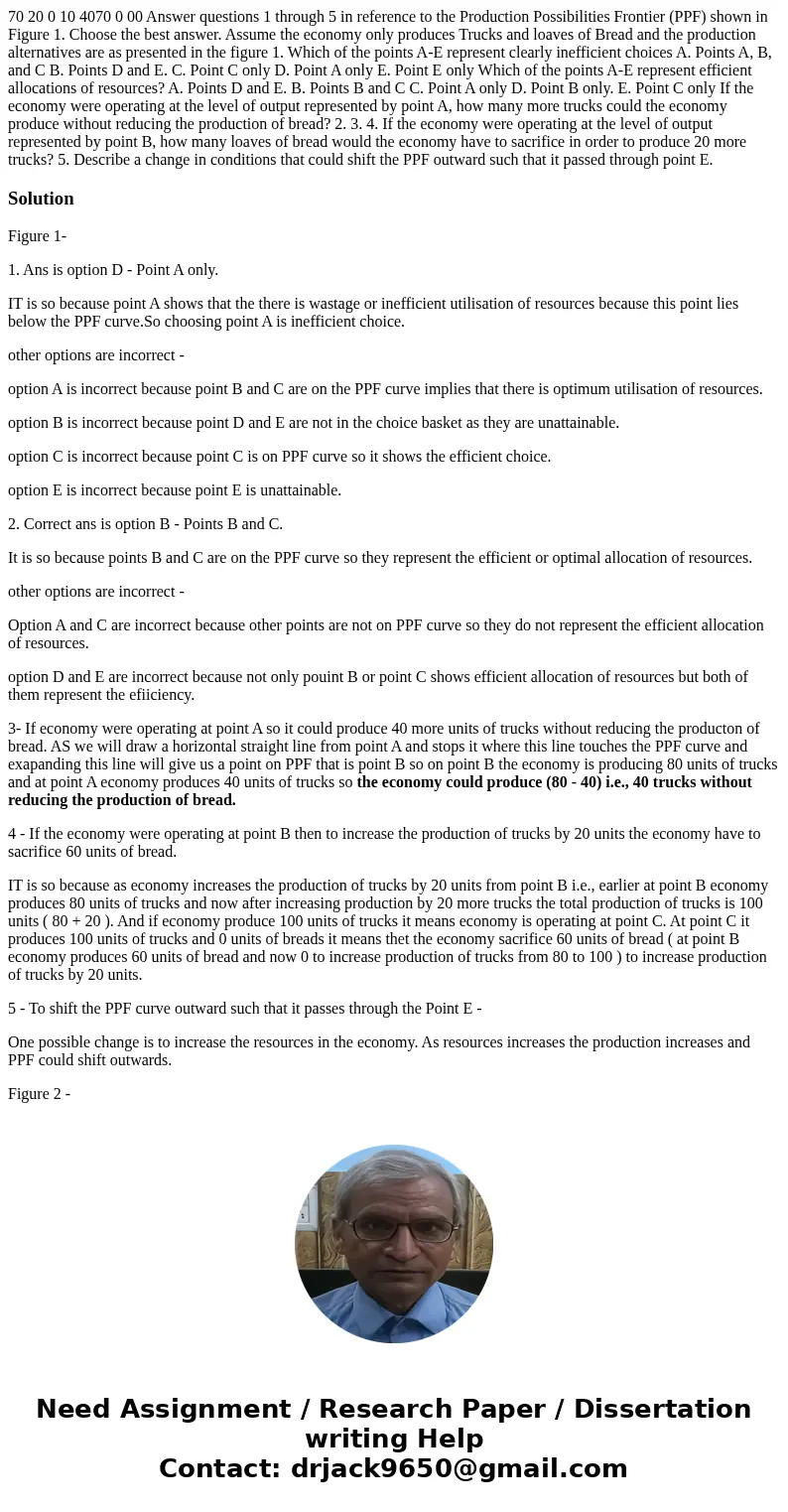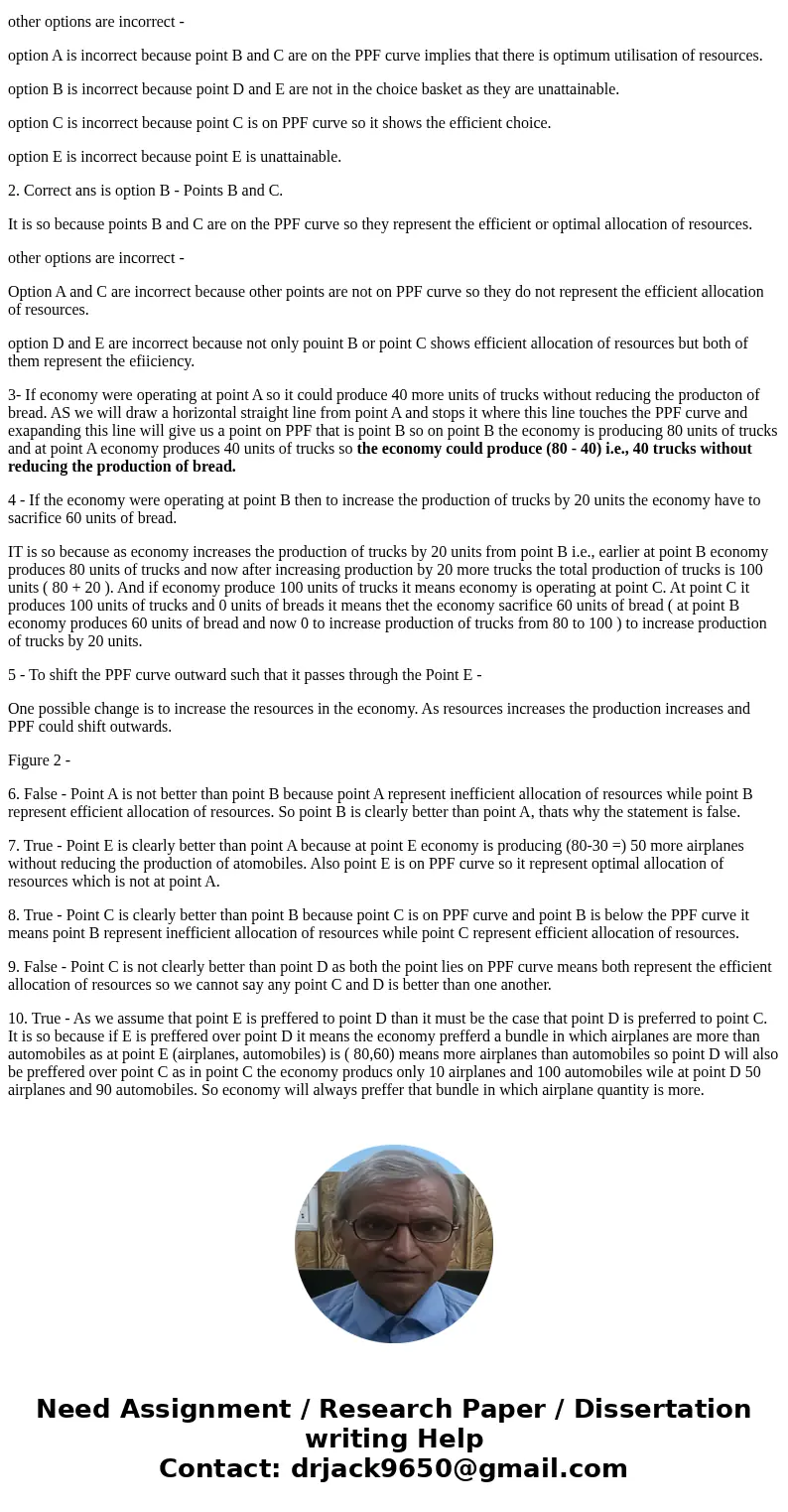70 20 0 10 4070 0 00 Answer questions 1 through 5 in referen
Solution
Figure 1-
1. Ans is option D - Point A only.
IT is so because point A shows that the there is wastage or inefficient utilisation of resources because this point lies below the PPF curve.So choosing point A is inefficient choice.
other options are incorrect -
option A is incorrect because point B and C are on the PPF curve implies that there is optimum utilisation of resources.
option B is incorrect because point D and E are not in the choice basket as they are unattainable.
option C is incorrect because point C is on PPF curve so it shows the efficient choice.
option E is incorrect because point E is unattainable.
2. Correct ans is option B - Points B and C.
It is so because points B and C are on the PPF curve so they represent the efficient or optimal allocation of resources.
other options are incorrect -
Option A and C are incorrect because other points are not on PPF curve so they do not represent the efficient allocation of resources.
option D and E are incorrect because not only pouint B or point C shows efficient allocation of resources but both of them represent the efiiciency.
3- If economy were operating at point A so it could produce 40 more units of trucks without reducing the producton of bread. AS we will draw a horizontal straight line from point A and stops it where this line touches the PPF curve and exapanding this line will give us a point on PPF that is point B so on point B the economy is producing 80 units of trucks and at point A economy produces 40 units of trucks so the economy could produce (80 - 40) i.e., 40 trucks without reducing the production of bread.
4 - If the economy were operating at point B then to increase the production of trucks by 20 units the economy have to sacrifice 60 units of bread.
IT is so because as economy increases the production of trucks by 20 units from point B i.e., earlier at point B economy produces 80 units of trucks and now after increasing production by 20 more trucks the total production of trucks is 100 units ( 80 + 20 ). And if economy produce 100 units of trucks it means economy is operating at point C. At point C it produces 100 units of trucks and 0 units of breads it means thet the economy sacrifice 60 units of bread ( at point B economy produces 60 units of bread and now 0 to increase production of trucks from 80 to 100 ) to increase production of trucks by 20 units.
5 - To shift the PPF curve outward such that it passes through the Point E -
One possible change is to increase the resources in the economy. As resources increases the production increases and PPF could shift outwards.
Figure 2 -
6. False - Point A is not better than point B because point A represent inefficient allocation of resources while point B represent efficient allocation of resources. So point B is clearly better than point A, thats why the statement is false.
7. True - Point E is clearly better than point A because at point E economy is producing (80-30 =) 50 more airplanes without reducing the production of atomobiles. Also point E is on PPF curve so it represent optimal allocation of resources which is not at point A.
8. True - Point C is clearly better than point B because point C is on PPF curve and point B is below the PPF curve it means point B represent inefficient allocation of resources while point C represent efficient allocation of resources.
9. False - Point C is not clearly better than point D as both the point lies on PPF curve means both represent the efficient allocation of resources so we cannot say any point C and D is better than one another.
10. True - As we assume that point E is preffered to point D than it must be the case that point D is preferred to point C. It is so because if E is preffered over point D it means the economy prefferd a bundle in which airplanes are more than automobiles as at point E (airplanes, automobiles) is ( 80,60) means more airplanes than automobiles so point D will also be preffered over point C as in point C the economy producs only 10 airplanes and 100 automobiles wile at point D 50 airplanes and 90 automobiles. So economy will always preffer that bundle in which airplane quantity is more.


 Homework Sourse
Homework Sourse